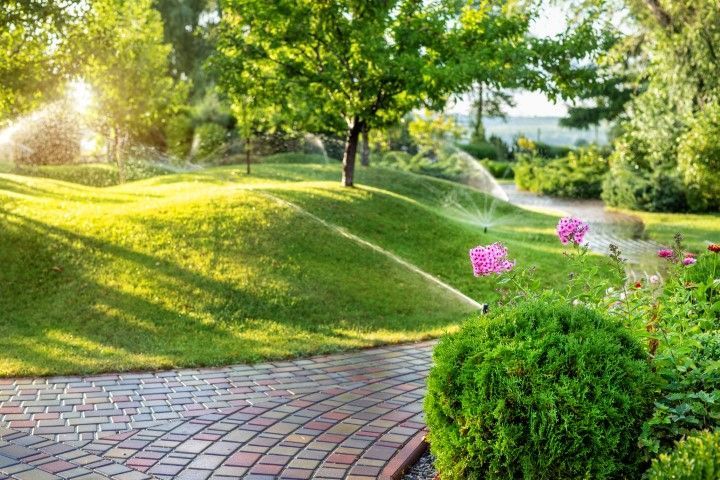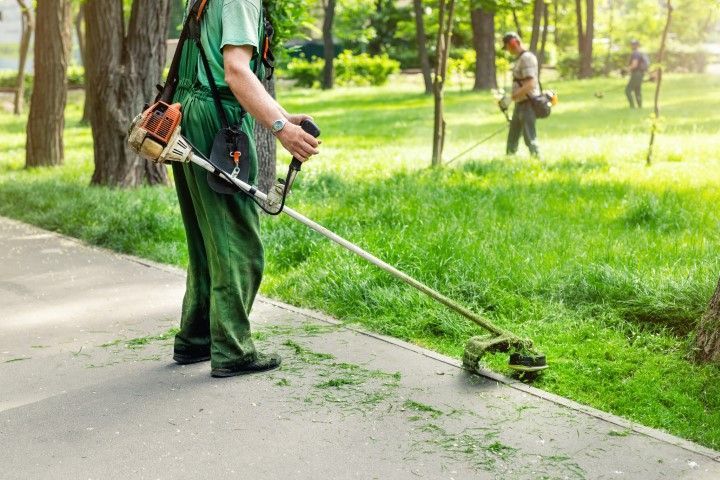Inglewood Landscaping
555-555-5555
Lawn Care And Maintenance in Inglewood CA
A beautiful lawn can enhance the appeal of your home, providing a lush green space for relaxation and outdoor activities. However, achieving and maintaining that picture-perfect lawn requires careful planning and consistent care. To keep your lawn healthy throughout the year, it's essential to develop a schedule of
lawn care in Inglewood, CA based on the seasons. Each season brings its own set of tasks that help promote growth and health.
Spring
As winter fades and temperatures rise, spring is the perfect time to kickstart your lawn care routine. Begin by assessing your lawn's condition. Remove debris, such as leaves and branches, that may have accumulated during the winter. Then, consider aerating your lawn to allow air, water, and nutrients to penetrate the soil more effectively.
Next, overseed any thin areas to promote a thicker, healthier lawn. Use a high-quality grass seed suitable for the Inglewood climate. Fertilizing in early spring will also help your grass wake up from dormancy and support robust growth.
Summer
Summer can be hot, so your lawn will require special attention. Ensure you are watering deeply and infrequently to encourage deep root growth. Aim for about an inch of water per week, adjusting based on rainfall. Early morning is the best time to water, reducing evaporation and disease risk.
Mowing should be regular, but avoid cutting the grass too short. Keeping your lawn at a height of 2.5 to 3 inches helps shade the roots and retain moisture. Also, consider applying a slow-release fertilizer during this season to provide a steady supply of nutrients.
Fall
As summer comes to an end, fall presents an excellent opportunity for lawn maintenance. Start by raking fallen leaves, which can suffocate your grass if left unattended. This is also the ideal time to aerate your lawn again, especially if you didn't do it in spring.
Consider overseeding once more, as this helps fill in bare patches and strengthen your lawn for the coming winter. Applying a fall fertilizer will provide essential nutrients to support growth before dormancy.
Winter
During the winter months, lawn care may slow down, but it’s still essential. Keep an eye out for any weeds that may try to establish themselves. You can spot-treat these as needed. Avoid heavy foot traffic on your lawn, as this can compact the soil and damage dormant grass.
If it rains heavily, ensure proper drainage to prevent water pooling, which can harm your lawn's health. Take the time during winter to plan your lawn care strategies for the coming year, ensuring you’re ready when spring arrives.
Maintaining a healthy lawn involves understanding the seasonal needs of your grass and creating a tailored care schedule. If you find lawn care overwhelming or simply lack the time to do it yourself, we’re here to help. Our team of experienced lawn care professionals is ready to assist you in achieving the lawn of your dreams. Contact us today to discuss your lawn care needs, schedule a consultation, or get a quote for our services. Together, we can create a vibrant outdoor space that you and your family will enjoy for years to come.

Different Lawn Care Methods to Enhance Your Yard’s Appeal
A well-maintained lawn enhances the beauty of any property, providing a fresh, inviting atmosphere for both homeowners and visitors. Achieving a lush, green lawn doesn’t happen by accident—it requires consistent care and attention to detail. From proper mowing and hardscaping to precise watering, maintaining a healthy lawn involves several key techniques. Whether you're looking to improve your current lawn or maintain its pristine condition, understanding these methods is crucial for long-term success. Let's explore some of the most effective lawn care and maintenance techniques.
Mowing Properly
Mowing your lawn correctly is essential for its overall health. It’s not just about cutting grass to the right length—it’s about timing, blade sharpness, and mowing patterns. Ideally, grass should be kept at a height that promotes deep root growth. Typically, you should never cut more than one-third of the grass blade at any time. Regular mowing also prevents weeds from taking over and encourages thicker grass growth. Additionally, ensuring your mower blades are sharp will create a cleaner cut, reducing stress on the grass and minimizing disease.
Watering Efficiently
Watering is another critical factor in lawn care, and many homeowners either water too much or too little. To maintain a green, healthy lawn, it’s essential to water deeply but infrequently. Lawns generally need about one inch of water per week, delivered either through rainfall or irrigation. Deep watering encourages the roots to grow deeper, which makes the grass more drought-resistant. Watering in the early morning is ideal, as it reduces water loss from evaporation and helps prevent fungal diseases that can occur when the lawn stays wet overnight.
Fertilization
Fertilizing your lawn provides it with the nutrients it needs to grow thick and vibrant. Grass requires essential nutrients like nitrogen, phosphorus, and potassium to thrive. Using the right type of fertilizer and applying it at the right time of year is crucial. Typically, lawns should be fertilized during the growing seasons—spring and fall. It’s also essential to follow proper application rates, as over-fertilization can burn the grass and lead to environmental pollution from runoff.
Aeration
Over time, lawns can become compacted due to foot traffic or heavy equipment, which restricts airflow and nutrient penetration. Aeration involves creating small holes in the soil to allow air, water, and nutrients to reach the roots more effectively. This process helps reduce soil compaction and promotes better root growth. Aerating once or twice a year, depending on the soil type and lawn conditions, can significantly improve the health and appearance of your lawn.
Weed Control
Weeds can quickly take over a lawn, competing with grass for nutrients, water, and sunlight. Controlling weeds is a critical part of lawn care, and it requires a proactive approach. Pre-emergent herbicides can be applied in early spring to prevent weed seeds from germinating, while post-emergent herbicides can target weeds that have already sprouted. However, the best defense against weeds is a healthy, thick lawn. By following proper mowing, watering, and fertilization practices, you can reduce the chances of weeds taking hold.
Pest and Disease Management
Lawn pests and diseases can wreak havoc on your grass if not properly managed. Grubs, chinch bugs, and fungal infections are common threats to a healthy lawn. Identifying the signs of pest infestation or disease early can prevent widespread damage. Regularly inspecting your lawn for signs of distress, such as brown patches or thinning areas, allows for timely intervention. Using natural or chemical treatments, along with improving overall lawn care practices, can help manage and prevent these issues.
Seasonal Maintenance
Each season presents unique challenges and opportunities for lawn care. In the spring, lawns need to be cleared of debris and prepped for the growing season with fertilization and weed control. Summer requires proper watering and mowing to withstand heat and drought. Fall is the time to aerate and apply fertilizers to prepare the lawn for the winter months. Consistent seasonal care helps maintain a beautiful, resilient lawn year-round.

Achieving a lush, healthy lawn takes dedication and expertise. We offer comprehensive lawn care services tailored to meet your lawn’s unique needs. From proper mowing and fertilization to pest control and seasonal maintenance, our team is here to ensure your lawn stays vibrant all year. Contact us today to schedule a consultation and let us help you achieve the lawn of your dreams!
Top 10 Common Lawn Care Mistakes to Avoid

A well-maintained lawn enhances the beauty of any property, offering a green space that’s both functional and visually appealing. However, achieving that perfect lawn isn’t always easy. Many homeowners unknowingly make mistakes that can prevent their lawn from thriving. Whether it's improper watering, mowing too short, or choosing the wrong grass type, these common errors can lead to a lawn that struggles to look its best. By avoiding these pitfalls, you can ensure your lawn stays healthy, vibrant, and lush all year long.
Overwatering the Lawn
One of the biggest mistakes is watering the lawn too much. While grass needs water to survive, too much can lead to shallow root systems and encourage disease. It’s essential to find a balance by watering deeply but less frequently. This promotes stronger roots, which can access water from deeper in the soil.
Mowing Too Short
Many homeowners think cutting the grass shorter will reduce the frequency of mowing. However, mowing too short can weaken the grass and expose the soil to direct sunlight, which dries it out quickly. The ideal approach is to mow more often but cut only a third of the blade’s height each time to keep the lawn healthy.
Ignoring Soil Health
Your lawn's health is directly related to the condition of the soil. Without testing the soil, you may not know its pH level or nutrient deficiencies. A soil test can help determine the right type of fertilizer and any adjustments needed to create optimal growing conditions for your grass.
Fertilizing at the Wrong Time
Fertilizing at the wrong time of year or over-fertilizing can harm your lawn. The best time to fertilize depends on the grass type, but generally, spring and fall are optimal periods. Over-fertilizing can burn the grass, leading to brown patches and weak growth.
Using the Wrong Type of Grass
Different grass types thrive in different climates and conditions. Choosing the wrong type for your region or yard’s sunlight exposure can result in a lawn that struggles to survive. It’s essential to select a grass variety that’s suited to your local environment and lawn’s specific needs.
Neglecting Aeration
Lawn aeration is the process of creating small holes in the soil to allow air, water, and nutrients to penetrate the grass roots. Many homeowners skip this step, but it’s crucial for maintaining healthy soil and preventing compaction. Aerating the lawn once or twice a year helps improve its overall health.
Inconsistent Watering Schedule
Watering too much on some days and too little on others can cause uneven growth and stress the grass. It's important to follow a consistent schedule, ideally early in the morning, when water can be absorbed before the sun evaporates it.
Not Dealing with Weeds Properly
Weeds compete with grass for nutrients, sunlight, and water. Failing to remove weeds early can allow them to spread and take over. Regular weeding, either manually or with herbicides, can help keep them under control and prevent them from choking out your lawn.
Skipping Lawn Maintenance in Winter
Even though the grass isn’t growing actively in winter, it’s still important to care for your lawn during the colder months. Clearing debris, avoiding heavy foot traffic, and preparing the lawn for the spring season will help ensure a healthier start when growth resumes.
Poor Mower Maintenance
Dull mower blades tear grass instead of cutting it cleanly, which leaves it vulnerable to disease and stress. Regularly sharpening mower blades and maintaining the mower itself ensures clean cuts that help the grass recover faster and look better.
A beautiful lawn requires more than just occasional watering or mowing. It takes knowledge, consistent care, and the right approach. If you’re unsure about your lawn care practices or need professional assistance, we’re here to help! Contact us today for expert lawn care advice or landscape design and installation to keep your lawn looking its best all year round.